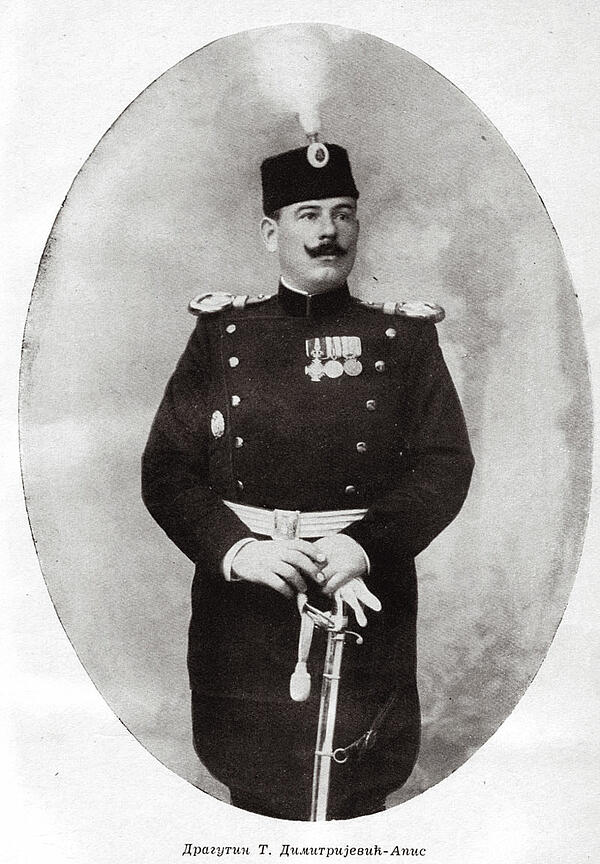The Black Hand Movement
The Black Hand movement was dedicated to freeing Bosnia from Austrian occupation and incorporating it into Greater Serbia. The movement is significant for its connection with the assassination of Archduke Franz Ferdinand and his wife at Sarajevo on 28 June 1914. This is often seen as the trigger cause of World War One, igniting existing European tensions.
The aim of the Black Hand movement was to unite South Slav territories in a Serbian state. The assassination of Franz Ferdinand fitted into the movement’s objective of destabilising Austria-Hungary. Its leader was Dragutin Dimitrijević - also known as ‘Apis’.
Serbia was modern in outlook and approach by 1914. King Alexander’s autocratic regime was replaced by a more democratic government. Political opposition was tolerated; a well-paid civil service organised the state and courts became independent entities. Although the domestic structure of Serbia was undergoing modernisation, many sought independence from the rule of Austro-Hungary and for all Serbs to be united in one state.
Dragutin Dimitrijević, or ‘Apis’, epitomised Serb nationalist feelings and as such, he had enormous power. In 1903, the Apis put all of his men in important roles in the army. Apis outlined his view: all Serbs were to be liberated from Austro-Hungarian rule and would and the powers of Vienna and Turkey were to be removed entirely.

The road to full Serbian independence had started many decades before. On 11 June 1903, Apis and a group of his junior officers assassinated the king of Serbia and his wife in the ‘May Coup’. Afterwards, Apis was hailed as "the saviour of the fatherland" and he was appointed Professor of Tactics at the Military Academy.
The ‘Serbian Defence’ also sent trained volunteers to help Serbs in Old Serbia and Macedonia secure independence from Bulgaria. In 1912 and 1913 they were successful and Old Serbia and Macedonia were returned to Serbia after the Bulgarians had been defeated.
Nationalist feeling was especially strong in areas where Serbian culture was suppressed by Austria-Hungary. In particular, in 1876 Austria-Hungary received Bosnia after an agreement between the Russians and Austria-Hungary. Two years later at the Congress of Berlin, Austria-Hungary was given a mandate to govern Bosnia and Herzegovina. Then, in 1908, Austria-Hungary decided to incorporate Bosnia and Herzegovina into her empire. Serbs in Bosnia were not allowed to celebrate St. Sava’s Day, the most important of Serbia’s saints and the singing of Serbia folk songs was banned.
Serbia complained but was threatened with war if there was any attempt made to intervene. On 31 March 1909, Serbia had to issue a statement recognising the new status of Bosnia and Herzegovina.
The Black Hand was born out of anger over Austro-Hungarian rule. In 1911, Apis founded ‘Union or Death’, which later became the Black Hand. This movement had two simple aims: the liberation of all Serbs under foreign rule and the creation of a Kingdom of Serbia that incorporated all Serbs. Any member of Black Hand had to sign a form that stated that he/she was willing to give up his/her life for the movement. They set about liaising with other known secret Serb organisations in Bosnia and Herzegovina. Terrorist action was encouraged against what ‘Black Hand’ believed were occupying forces.
The assassination of Franz Ferdinand was a reaction to the threat posed by Austria-Hungary. In 1914, Austria-Hungary announced that she would conduct military manoeuvres in Bosnia next to the Serbian border. This was interpreted as a threat by the Black Hand. Franz Ferdinand’s planned visit to Sarajevo on 28 June seemed like the perfect opportunity to take action.
See also: Defence of the Realm Act of 1914
MLA Citation/Reference
"The Black Hand Movement". HistoryLearning.com. 2026. Web.
